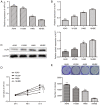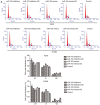MicroRNA‑103 modulates tumor progression by targeting KLF7 in non‑small cell lung cancer
- PMID: 32582959
- PMCID: PMC7387085
- DOI: 10.3892/ijmm.2020.4649
MicroRNA‑103 modulates tumor progression by targeting KLF7 in non‑small cell lung cancer
Abstract
Numerous studies have identified that microRNAs (miRs) play a crucial role in the tumorigenesis of non‑small cell lung cancer (NSCLC). However, to the best of our knowledge, the physiological function of miR‑103 in NSCLC is not fully understood. Experiments in the present study revealed that miR‑103 expression was increased in NSCLC cell lines. In addition, a series of methods, including MTT, colony formation, 5‑ethynyl‑2'‑deoxyuridine, Transwell, wound healing, flow cytometric, reverse transcription‑quantitative PCR and western blot assays, were performed, which revealed that overexpression of miR‑103 enhanced cell growth, migration, invasion and epithelial‑mesenchymal transition (EMT), and suppressed apoptosis of A549 and H1299 cells. Additionally, a dual‑luciferase reporter assay indicated that miR‑103 directly targets the 3'‑untranslated region of Kruppel‑like factor 7 (KLF7), and KLF7 expression was negatively regulated by miR‑103 expression. Furthermore, the present findings demonstrated that miR‑103 promoted EMT via regulating the Wnt/β‑catenin signaling pathway in NSCLC. Collectively, the current results demonstrated that miR‑103 serves a tumorigenesis role in NSCLC development by targeting KLF7, at least partly via the Wnt/β‑catenin signaling pathway. Consequently, these findings indicated that miR‑103/KLF7/Wnt/β‑catenin may provide a novel insight into underlying biomarkers for improving the diagnosis and treatment of NSCLC.
Figures

















Similar articles
-
STAT3-induced long noncoding RNA LINC00668 promotes migration and invasion of non-small cell lung cancer via the miR-193a/KLF7 axis.Biomed Pharmacother. 2019 Aug;116:109023. doi: 10.1016/j.biopha.2019.109023. Epub 2019 May 28. Biomed Pharmacother. 2019. PMID: 31150989
-
miR-185 Inhibits the Proliferation and Invasion of Non-Small Cell Lung Cancer by Targeting KLF7.Oncol Res. 2019 Sep 23;27(9):1015-1023. doi: 10.3727/096504018X15247341491655. Epub 2018 May 1. Oncol Res. 2019. PMID: 29716672 Free PMC article.
-
UBE2C, Directly Targeted by miR-548e-5p, Increases the Cellular Growth and Invasive Abilities of Cancer Cells Interacting with the EMT Marker Protein Zinc Finger E-box Binding Homeobox 1/2 in NSCLC.Theranostics. 2019 Mar 17;9(7):2036-2055. doi: 10.7150/thno.32738. eCollection 2019. Theranostics. 2019. Retraction in: Theranostics. 2020 Jul 25;10(21):9619. doi: 10.7150/thno.50254. PMID: 31037155 Free PMC article. Retracted.
-
Emerging role of sirtuins in non‑small cell lung cancer (Review).Oncol Rep. 2024 Oct;52(4):127. doi: 10.3892/or.2024.8786. Epub 2024 Aug 2. Oncol Rep. 2024. PMID: 39092574 Free PMC article. Review.
-
Molecular function of Krüppel-like factor 7 in biology.Acta Biochim Biophys Sin (Shanghai). 2023 May 24;55(5):713-725. doi: 10.3724/abbs.2023061. Acta Biochim Biophys Sin (Shanghai). 2023. PMID: 37227154 Free PMC article. Review.
Cited by
-
Effects of miR-132-3p on progress and epithelial mesenchymal transition of non-small cell lung cancer via regulating KLF7.J Thorac Dis. 2021 Apr;13(4):2426-2436. doi: 10.21037/jtd-21-353. J Thorac Dis. 2021. PMID: 34012590 Free PMC article.
-
Comprehensive Analysis and Reinforcement Learning of Hypoxic Genes Based on Four Machine Learning Algorithms for Estimating the Immune Landscape, Clinical Outcomes, and Therapeutic Implications in Patients With Lung Adenocarcinoma.Front Immunol. 2022 Jun 10;13:906889. doi: 10.3389/fimmu.2022.906889. eCollection 2022. Front Immunol. 2022. PMID: 35757722 Free PMC article.
-
Identification of a competing endogenous RNA axis "SVIL-AS1/miR-103a/ICE1" associated with chemoresistance in lung adenocarcinoma by comprehensive bioinformatics analysis.Cancer Med. 2021 Sep;10(17):6022-6034. doi: 10.1002/cam4.4132. Epub 2021 Jul 15. Cancer Med. 2021. PMID: 34264003 Free PMC article.
-
Kruppel like factor 16 promotes lung adenocarcinoma progression by upregulating lamin B2.Bioengineered. 2022 Apr;13(4):9482-9494. doi: 10.1080/21655979.2022.2060780. Bioengineered. 2022. PMID: 35387557 Free PMC article.
-
Inhibition of miR-185-3p Confers Erlotinib Resistance Through Upregulation of PFKL/MET in Lung Cancers.Front Cell Dev Biol. 2021 Jul 21;9:677860. doi: 10.3389/fcell.2021.677860. eCollection 2021. Front Cell Dev Biol. 2021. PMID: 34368128 Free PMC article.
References
-
- Goldstraw P, Chansky K, Crowley J, Porta RR, Asamura H, Eberhardt WE, Nicholson AG, Groome P, Mitchell A, Bolejack V, et al. The IASLC lung cancer staging project: Proposals for revision of the tnm stage groupings in the forthcoming (Eighth) edition of the TNM classification for lung cancer. J Thorac Oncol. 2016;11:39–51. doi: 10.1016/j.jtho.2015.09.009. - DOI - PubMed
MeSH terms
Substances
LinkOut - more resources
Full Text Sources
Medical

